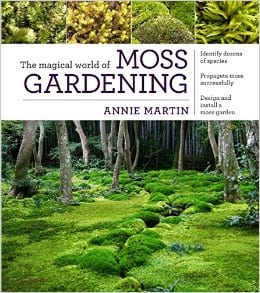 Written by Annie Martin
Written by Annie Martin
Published by Timber Press, 2015
Reviewed by Amanda Sloan
No matter whether you are a landscape professional, a designer, a home gardener, a naturalist, an ecologist, or a teacher of botany, I predict this book will become an essential part of your library soon! Written with intimate scientific knowledge of its subject, The Magical World of Moss Gardening manages effortlessly to present the world of moss gardening warmly, comprehensively, and beautifully. It would be the perfect gift for your plant/garden/landscape loved ones this holiday season. When guests arrive for your holiday gathering, you can take it off your professional bookshelf and leave it on your coffee table, where it will be equally at home.
The author is Annie Martin, aka “Mossin’ Annie,” a North Carolina native who loved moss since her early childhood forays in the Blue Ridge Mountains. She is a member of the American Bryological and Lichenological Society, the International Association of Bryologists, and the American Horticultural Society and is well known as a moss expert. She is also a talented writer and a designer of moss landscapes, many of which she beautifully photographed herself for this book.
The Magical World of Moss Gardening begins with a visual tour of moss gardens around the world. These images offer great inspiration for garden designers who are looking for ways to work with moss. Ms. Martin then provides backup with a chapter on the botany and natural history of mosses. The next section, “Bryophytes to Know and Grow,” provides photos and a description of each moss species and will delight plant geeks (I include myself!) who enjoy poring over nursery catalogs figuring out which plant to put where. Ms. Martin then walks the reader through the creation of a moss garden, from design through planting, propagation, maintenance, and troubleshooting.
Of particular interest in ecological landscapes, mosses are plants that can be used in many situations where other plants would not thrive, such as extreme shade, compacted or even paved areas, and high-traffic areas. Green roofs and green walls are newer practices where moss is being used with great success.
Ms. Martin writes with the ecological perspective in mind, providing information on collection of rainwater for irrigating moss gardens and on converting grass lawns to moss lawns. I was especially pleased with her section on obtaining moss. Moss is everywhere, but moss nurseries are just gaining traction at this time. She clearly describes what to look for in a moss supplier, which collection practices are ethical and which are not, and, should the gardener decide to go the collecting route, the differences between rescuing, harvesting, and stealing mosses. Two keys are to watch for areas where woodland is soon to be destroyed for development and always to ask the owner’s permission before collecting. In Ms. Martin’s area, native plant societies conduct plant rescue missions on sites soon to be developed, and moss can be included in this rescue activity.
After reading this book I am already dreaming up sites for my own moss gardens … that dark, boulder-y corner of my yard for a Japanese-inspired moss garden? The shady area under that pedestrian bridge I’m working on at the office? I’ll be going right to The Magical World of Moss Gardening both for inspiration and information.
About the Reviewer
Amanda Sloan, RLA, ASLA, has worked for over 22 years to bring beauty as well as function to the design of parks and trails throughout New England. Amanda combines her background in natural science, community design, and art on projects such as school and playground gardens, lakeside parks, recreation sites, rain gardens, and home landscapes. Amanda is currently a landscape architect with BETA Group where she specializes in rain garden design and native plants.

